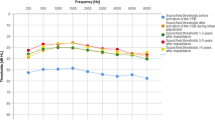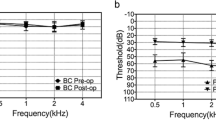Abstract
Purpose
to assess audiological performance in quiet and noise, quality of life and side effects of Vibrant Soundbridge (VSB) in children with congenital aural atresia (CAA).
Methods
A retrospective study including consecutive patients with unilateral or bilateral CAA implanted with VSB from 2009 to 2020 in a tertiary referral centre.
Results
18 patients with CAA and a present stapes were included (3 simultaneous bilateral VSB implants) and 21 ears: 17 VSB were attached to the short incus process, and four to the stapes. Age at implantation ranged from 4.7 to 15.8 years. Average follow-up was 6.5 years (± 3.7 years). In unilateral VSB, air conduction pure tone average (ACPTA) thresholds increased from 75.3 ± 15.2 to 32.6 ± 8.3 dB post-operatively (VSB activated) (n = 15; p < 0.01). The speech reception threshold (SRT) and the word recognition score (WRS) were significantly improved from 81.5 ± 10.4 to 43.9 ± 7.6 dB and 0% to 84.8 ± 8.5% postoperatively (n = 15; p < 0.01). The signal to noise ratio (SNR) was significantly improved from 2.1 ± 2.9 dB VSB inactivated to 0.3 ± 2.7 dB VSB activated (n = 15; p < 0.01). There was no significant difference in performance according to floating mass transducer (FMT) placement. 5/15 children were non-users at last follow-up in unilateral VSB and 0/3 in bilateral.
Conclusions
CAA ears with VSB activated had a significant improvement of ACPTA, WRS, SRT and SNR. A third of patients with unilateral CAA became non-users at last follow-up. The main challenge is to target the indications for the implantation of the VSB to avoid its discontinuation.

Similar content being viewed by others
References
Abdel-Aziz M (2013) Congenital aural atresia. J Craniofac Surg 24:e418-422
Luquetti DV, Heike CL, Hing AV et al (2012) Microtia: epidemiology and genetics. Am J Med Genet A 158A:124–139
Leinung M, Zaretsky E, Lange BP et al (2017) Vibrant Soundbridge® in preschool children with unilateral aural atresia: acceptance and benefit. Eur Arch Otorhinolaryngol 274:159–165
Kumpik DP, King AJ (2019) A review of the effects of unilateral hearing loss on spatial hearing. Hear Res 372:17–28
Lloyd S, Almeyda J, Sirimanna KS et al (2007) Updated surgical experience with bone-anchored hearing aids in children. J Laryngol Otol 121:826–831
Agterberg MJH, Hol MKS, Cremers CWRJ et al (2011) Conductive hearing loss and bone conduction devices: restored binaural hearing? Adv Otorhinolaryngol 71:84–91
Célérier C, Thierry B, Coudert C et al (2017) Results of VSB implantation at the short process of the incus in children with ear atresia. Int J Pediatr Otorhinolaryngol 93:83–87
Maier H, Baumann U, Baumgartner W-D et al (2018) Minimal reporting standards for active middle ear hearing implants. Audiol Neurootol 23:105–115
Galvin KL, Noble W (2013) Adaptation of the speech, spatial, and qualities of hearing scale for use with children, parents, and teachers. Cochlear Implants Int 14:135–141
Gatehouse S, Noble W (2004) The speech, spatial and qualities of hearing scale (SSQ). Int J Audiol 43:85–99
Moulin A, Pauzie A, Richard C (2015) Validation of a French translation of the Speech, Spatial, and Qualities of Hearing Scale (SSQ) and comparison with other language versions. Int J Audiol 54:889–898
von Elm E, Altman DG, Egger M et al (2014) The Strengthening the Reporting of Observational Studies in Epidemiology (STROBE) Statement: guidelines for reporting observational studies. Int J Surg 12:1495–1499
Frenzel H, Sprinzl G, Streitberger C et al (2015) The vibrant soundbridge in children and adolescents: preliminary European multicenter results. Otol Neurotol 36:1216–1222
Lailach S, Zahnert T, Maurer J et al (2020) The vibrating ossicular prosthesis in children and adolescents: a retrospective study. Eur Arch Otorhinolaryngol 277:55–60
Frenzel H, Hanke F, Beltrame M et al (2009) Application of the Vibrant Soundbridge to unilateral osseous atresia cases. Laryngoscope 119:67–74
Müller A, Mir-Salim P, Zellhuber N et al (2017) Influence of floating-mass transducer coupling efficiency for active middle-ear implants on speech recognition. Otol Neurotol 38:809–814
Fröhlich L, Rahne T, Plontke SK et al (2021) Intraoperative quantification of floating mass transducer coupling quality in active middle ear implants: a multicenter study. Eur Arch Otorhinolaryngol 278:2277–2288
Clarós P, Pujol del MC (2013) Active middle ear implants: VibroplastyTM in children and adolescents with acquired or congenital middle ear disorders. Acta Otolaryngol 133:612–619
Lesinskas E, Stankeviciute V, Petrulionis M (2012) Application of the Vibrant Soundbridge middle-ear implant for aural atresia in patients with Treacher Collins syndrome. J Laryngol Otol 126:1216–1223
Roman S, Denoyelle F, Farinetti A et al (2012) Middle ear implant in conductive and mixed congenital hearing loss in children. Int J Pediatr Otorhinolaryngol 76:1775–1778
Hempel J-M, Sprinzl G, Riechelmann H et al (2019) A Transcutaneous active middle ear implant (AMEI) in children and adolescents: long-term, multicenter results. Otol Neurotol 40:1059–1067
Frenzel H, Schönweiler R, Hanke F et al (2012) The Lübeck flowchart for functional and aesthetic rehabilitation of aural atresia and microtia. Otol Neurotol 33:1363–1367
Morton CC, Nance WE (2006) Newborn hearing screening–a silent revolution. N Engl J Med 354:2151–2164
Vogt K, Frenzel H, Ausili SA et al (2018) Improved directional hearing of children with congenital unilateral conductive hearing loss implanted with an active bone-conduction implant or an active middle ear implant. Hear Res 370:238–247
Agterberg MJH, Frenzel H, Wollenberg B et al (2014) Amplification options in unilateral aural atresia: an active middle ear implant or a bone conduction device? Otol Neurotol 35:129–135
Özdemir S, Tuncer Ü, Tarkan Ö et al (2013) Factors contributing to limited or non-use in the cochlear implant systems in children: 11 years experience. Int J Pediatr Otorhinolaryngol 77:407–409
Markey AL, Nichani J, Lockley M et al (2015) Cochlear implantation in adolescents: factors influencing compliance. Cochlear Implants Int 16:186–194
Sargsyan S, Rahne T, Kösling S et al (2014) Hearing rehabilitation with single-stage bilateral vibroplasty in a child with Franceschetti syndrome. Eur Arch Otorhinolaryngol 271:1339–1343
Chandrasekhar SS, De la Cruz A, Garrido E (1995) Surgery of congenital aural atresia. Am J Otol 16:713–717
Jahrsdoerfer RA, Lambert PR (1998) Facial nerve injury in congenital aural atresia surgery. Am J Otol 19:283–287
Kiefer J, Staudenmaier R (2010) Combined aesthetic and functional reconstruction of ear malformations. Adv Otorhinolaryngol 68:81–94
Kelley PE, Scholes MA (2007) Microtia and congenital aural atresia. Otolaryngol Clin N Am 40(61–80):vi
De la Cruz A, Teufert KB (2003) Congenital aural atresia surgery: long-term results. Otolaryngol Head Neck Surg 129:121–127
Keller WD, Bundy RS (1980) Effects of unilateral hearing loss upon educational achievement. Child Care Health Dev 6:93–100
Ito K (1998) Can unilateral hearing loss be a handicap in learning? Arch Otolaryngol Head Neck Surg 124:1389–1390
Lieu JEC (2004) Speech-language and educational consequences of unilateral hearing loss in children. Arch Otolaryngol Head Neck Surg 130:524–530
Priwin C, Jönsson R, Magnusson L et al (2007) Audiological evaluation and self-assessed hearing problems in subjects with single-sided congenital external ear malformations and associated conductive hearing loss. Int J Audiol 46:162–171
Author information
Authors and Affiliations
Corresponding author
Ethics declarations
Conflict of interest
The authors declare no conflict of interest.
Additional information
Publisher's Note
Springer Nature remains neutral with regard to jurisdictional claims in published maps and institutional affiliations.
Supplementary Information
Below is the link to the electronic supplementary material.
Rights and permissions
Springer Nature or its licensor holds exclusive rights to this article under a publishing agreement with the author(s) or other rightsholder(s); author self-archiving of the accepted manuscript version of this article is solely governed by the terms of such publishing agreement and applicable law.
About this article
Cite this article
Cadre, B., Simon, F., Célérier, C. et al. Long-term outcomes of retrospective case series of middle ear implantation with Vibrant Soundbridge in children with congenital aural atresia. Eur Arch Otorhinolaryngol 280, 1629–1637 (2023). https://doi.org/10.1007/s00405-022-07633-y
Received:
Accepted:
Published:
Issue Date:
DOI: https://doi.org/10.1007/s00405-022-07633-y




